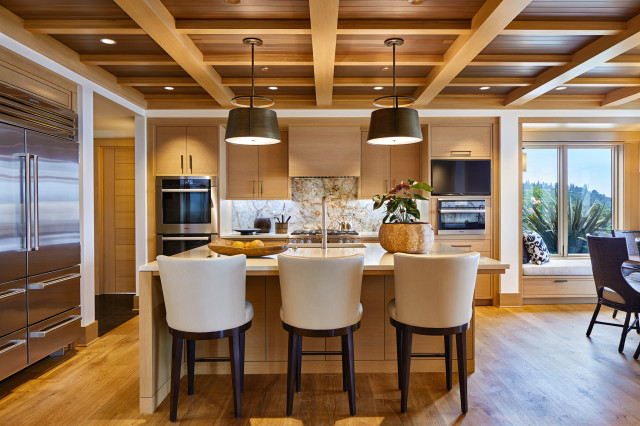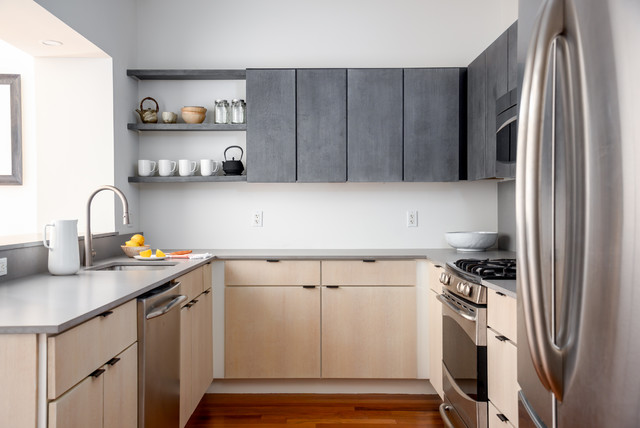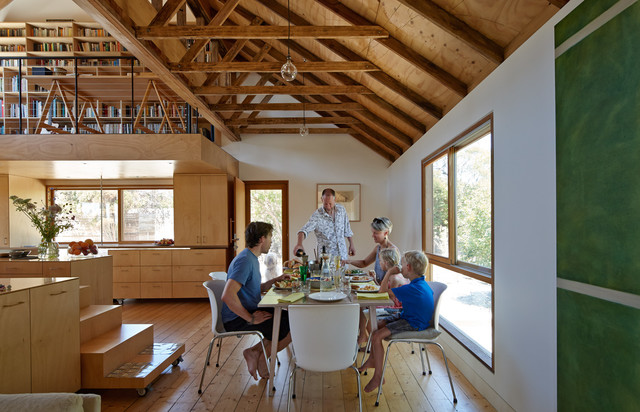10 Things to Do for a Smooth Renovation
1. Assemble a Good Team
Don’t jump to hire the least expensive designer, architect or builder unless they also come highly rated, well-regarded and positively reviewed. Have a thorough chat with their past clients to make sure there are no red flags. Ask to see examples of recently completed projects to make sure they have a proven track record.
Hiring the best team may mean having to cut back on something to make the budget work. But I guarantee it will be money well spent. And often you’ll save more money in the long run than if you had simply gone with the lowest bid.
On a related note, it’s a good idea to bring together professionals who have prior, positive experiences working together. Ask your architect or designer to recommend builders they’ve previously worked with. Or if you have a great builder on board but need an architect or designer, ask the builder to recommend someone they have a proven track record with. Think of it like a good marriage — you want to bring together people who can communicate effectively and resolve problems quickly, efficiently and amicably.
On a related note, it’s a good idea to bring together professionals who have prior, positive experiences working together. Ask your architect or designer to recommend builders they’ve previously worked with. Or if you have a great builder on board but need an architect or designer, ask the builder to recommend someone they have a proven track record with. Think of it like a good marriage — you want to bring together people who can communicate effectively and resolve problems quickly, efficiently and amicably.
2. Settle Budget and Scope Before You Begin
Before you even start dreaming about demo day, get a firm handle on your project scope and budget.
I’ve seen this scenario happen to people before: Imagine being on year two of a remodel that was originally supposed to be just a master suite renovation. You experienced major “scope creep” and started adding and adding to the project, then got stopped in your tracks when the city caught wind and insisted you update your permits (something that can take ages to resolve in a place like San Francisco). You’ve gone over budget, especially since you had to cover such a long stay in temporary housing. And so on.
So think long and hard about the scope of work before you get started, and then stick to it so you’re done on time and within range of your intended budget.
Before you even start dreaming about demo day, get a firm handle on your project scope and budget.
I’ve seen this scenario happen to people before: Imagine being on year two of a remodel that was originally supposed to be just a master suite renovation. You experienced major “scope creep” and started adding and adding to the project, then got stopped in your tracks when the city caught wind and insisted you update your permits (something that can take ages to resolve in a place like San Francisco). You’ve gone over budget, especially since you had to cover such a long stay in temporary housing. And so on.
So think long and hard about the scope of work before you get started, and then stick to it so you’re done on time and within range of your intended budget.
3. Include Budget and Timeline Contingencies
Make sure you are prepared for “worst-case scenarios” because, inevitably, they’ll happen. You’ve probably heard it’s a good idea to add a 1% to 20% contingency to your budget, but you should also add the same amount to your timeline.
Of course, the budget contingency also depends on the scope. If you are practically rebuilding from the ground up, you might be able to get away with 15%, or even 10%, because there shouldn’t be too many unknowns. (You are redoing everything, after all). But if your remodel involves working with existing elements, the condition of which won’t be revealed until demo day, you definitely need to have at least 20% set aside for unknowns.
Make sure you are prepared for “worst-case scenarios” because, inevitably, they’ll happen. You’ve probably heard it’s a good idea to add a 1% to 20% contingency to your budget, but you should also add the same amount to your timeline.
Of course, the budget contingency also depends on the scope. If you are practically rebuilding from the ground up, you might be able to get away with 15%, or even 10%, because there shouldn’t be too many unknowns. (You are redoing everything, after all). But if your remodel involves working with existing elements, the condition of which won’t be revealed until demo day, you definitely need to have at least 20% set aside for unknowns.
4. Consider Temporary Housing
If you are only redoing the kitchen or a single bathroom (and you have another to use), then you can likely stay put. But if you are doing a major remodel, in which plumbing and electrical will be down for some time throughout your entire house, you should seriously consider staying elsewhere. You and your family’s sanity is worth the extra expense of temporary housing. If you think that extra expense sounds crazy, I strongly recommend reducing the scope of your project or going with less-expensive finishes to help offset the cost of moving out during a major renovation.
Not only will it help keep your stress level down, but your project will also move along faster if subcontractors don’t have to work around you. This will save time, money and frustration.
If you are only redoing the kitchen or a single bathroom (and you have another to use), then you can likely stay put. But if you are doing a major remodel, in which plumbing and electrical will be down for some time throughout your entire house, you should seriously consider staying elsewhere. You and your family’s sanity is worth the extra expense of temporary housing. If you think that extra expense sounds crazy, I strongly recommend reducing the scope of your project or going with less-expensive finishes to help offset the cost of moving out during a major renovation.
Not only will it help keep your stress level down, but your project will also move along faster if subcontractors don’t have to work around you. This will save time, money and frustration.
5. Make and Finalize Selections Early
The last thing you want is to stall your project because the tile you’ve had your heart set on is temporarily out of stock.
It’s up to you how involved you want to be in making selections. Some homeowners prefer a hands-off approach and want the designer to pick everything. Others prefer to do the bulk of the legwork and then get advice and feedback from their designer. Either way, make sure someone is on top of availability and lead times for items so you don’t have a stressful, last-minute scramble to do research and make selections. You want to avoid having to make a major decision under pressure.
A good interior designer, architect or project manager is going to be on top of this, but if you plan to be involved in making selections, ask early on for a spreadsheet, software program or mobile app that lists and tracks material, finish, fixture and appliance selections so you know all of the parts and pieces needed and when they need to be selected.
The last thing you want is to stall your project because the tile you’ve had your heart set on is temporarily out of stock.
It’s up to you how involved you want to be in making selections. Some homeowners prefer a hands-off approach and want the designer to pick everything. Others prefer to do the bulk of the legwork and then get advice and feedback from their designer. Either way, make sure someone is on top of availability and lead times for items so you don’t have a stressful, last-minute scramble to do research and make selections. You want to avoid having to make a major decision under pressure.
A good interior designer, architect or project manager is going to be on top of this, but if you plan to be involved in making selections, ask early on for a spreadsheet, software program or mobile app that lists and tracks material, finish, fixture and appliance selections so you know all of the parts and pieces needed and when they need to be selected.
6. Check In on the Job Site, but Don’t Be a Nuisance
Even if your designer or architect is performing construction observation on your behalf, it’s still a good idea to stop by yourself regularly to see how things are going. But don’t interrogate or get in the way of the subcontractors on site.
If you followed the first piece of advice and assembled a strong team, you should be able to trust them to do their jobs correctly. Of course, nobody is perfect, and if you see something that doesn’t seem right, talk to whoever is managing the project and serving as your liaison to the rest of the team — your designer, architect or contractor.
Even if your designer or architect is performing construction observation on your behalf, it’s still a good idea to stop by yourself regularly to see how things are going. But don’t interrogate or get in the way of the subcontractors on site.
If you followed the first piece of advice and assembled a strong team, you should be able to trust them to do their jobs correctly. Of course, nobody is perfect, and if you see something that doesn’t seem right, talk to whoever is managing the project and serving as your liaison to the rest of the team — your designer, architect or contractor.
7. Build It Right the First Time
I know it isn’t fun to pay for things you can’t see, but don’t skimp on the fundamental elements of your home — the foundation, structure, insulation, waterproofing, mechanicals, etc.
There are areas where you can cut the budget if needed, but these should not be it. It’s crucial to invest in the fundamentals to get a solid, smooth-running, water-tight house that stays that way for many, many years.
I know it isn’t fun to pay for things you can’t see, but don’t skimp on the fundamental elements of your home — the foundation, structure, insulation, waterproofing, mechanicals, etc.
There are areas where you can cut the budget if needed, but these should not be it. It’s crucial to invest in the fundamentals to get a solid, smooth-running, water-tight house that stays that way for many, many years.
8. Know Where You Can Skimp if Needed
If you followed the last piece of advice, you’ll have a solid structure that you then get to fill with the fun stuff. If your budget is experiencing upward pressure and you need to trim some costs, you can save a large chunk of change by making a few small adjustments, such as switching to lower-cost finish materials, keeping the paint job simple (fewer differing colors and sheens) and swapping high-end appliances and fixtures for more moderately priced options.
If you followed the last piece of advice, you’ll have a solid structure that you then get to fill with the fun stuff. If your budget is experiencing upward pressure and you need to trim some costs, you can save a large chunk of change by making a few small adjustments, such as switching to lower-cost finish materials, keeping the paint job simple (fewer differing colors and sheens) and swapping high-end appliances and fixtures for more moderately priced options.
Basically anything that is fairly easy to upgrade later on is a potential candidate for value engineering. It’s not a big deal to postpone installing that beautiful (but pricey) backsplash tile you’ve had your heart set on, but it’s much more difficult to correct shoddy rough-in plumbing work after the fact.
This is another area in which having a good design and build team is invaluable: They’ll be able to identify areas where you can trim costs as well as items worth splurging on now.
This is another area in which having a good design and build team is invaluable: They’ll be able to identify areas where you can trim costs as well as items worth splurging on now.
9. Careful About Those Change Orders
For those unfamiliar with the term, a change order in this context is simply an amendment to the contract, typically between the homeowner and contractor. It’s used to add or delete something to the contracted scope of work. Want to move the location of a recessed light after it’s installed? That will trigger a change order. Yes, change orders are sometimes necessary, but they can cost you serious money, and usually at a time when you are quickly running out of it.
This is why fully thinking through the scope of work before you get started is key. It helps keep those change orders to a minimum.
The 4 Potentially Most Expensive Words in Remodeling
For those unfamiliar with the term, a change order in this context is simply an amendment to the contract, typically between the homeowner and contractor. It’s used to add or delete something to the contracted scope of work. Want to move the location of a recessed light after it’s installed? That will trigger a change order. Yes, change orders are sometimes necessary, but they can cost you serious money, and usually at a time when you are quickly running out of it.
This is why fully thinking through the scope of work before you get started is key. It helps keep those change orders to a minimum.
The 4 Potentially Most Expensive Words in Remodeling
10. Keep Perspective and Your Sense of Humor
Yes, things often don’t go as planned, and it’s a super stressful process, especially when budget and timeline get squeezed. But you need to find a healthy way to let off steam. (I highly recommend yoga.)
You’ve got to be able to laugh off the little things and, if the going gets really tough, try to visualize the end result: a finished home that you are going to love living in for years to come. So good luck!
Yes, things often don’t go as planned, and it’s a super stressful process, especially when budget and timeline get squeezed. But you need to find a healthy way to let off steam. (I highly recommend yoga.)
You’ve got to be able to laugh off the little things and, if the going gets really tough, try to visualize the end result: a finished home that you are going to love living in for years to come. So good luck!











Comments
Post a Comment